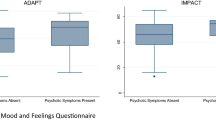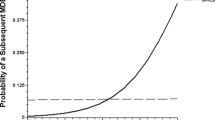Abstract
Adolescence is marked by increases in the incidence of major depression (MDD), a disorder recognized as one of the leading causes of disability. Anhedonia and depressed mood predict both onset and chronicity of major depression (MDD), but have never been studied together longitudinally in the general adolescent population. The present study examined (1) the course and the stability of anhedonia and depressed mood and (2) their cross-sectional and longitudinal relations during adolescence. The study cohort consisted of 2,230 adolescents. Anhedonia and depressed mood were assessed with items of the YSR and ASR self-report forms at four measurement waves between ages 11 and 19. The proportion of adolescents reporting anhedonia decreased between ages 11 and 19, while the proportion of female adolescents reporting depressed mood increased. The stability of anhedonia and the cross-sectional association between anhedonia and depressed mood was larger at age 19 than at age 11. We found a mutual association between anhedonia and depressed mood without a clear temporal sequence. The presence of anhedonia at the end of adolescence might put adolescents at increased risk for MDD given the increasingly stronger stability and association with depressed mood. This suggests that it becomes more difficult to prevent MDD during late adolescence compared with early and middle adolescence.

Similar content being viewed by others
References
Hankin BL, Abramson LY, Moffitt TE, Silva PA, McGee R, Angell KE (1998) Development of depression from preadolescence to young adulthood: emerging gender differences in a 10-year longitudinal study. J Abnorm Psychol 107:128–140
Oldehinkel AJ, Wittchen HU, Schuster P (1999) Prevalence, 20-month incidence and outcome of unipolar depressive disorders in a community sample of adolescents. Psychol Med 29:655–668
Mathers CD, Loncar D (2006) Projections of global mortality and burden of disease from 2002 to 2030. PLoS Med 3:e442
World Health Organization (2008) The global burden of disease: 2004 update. World Health Organization, Geneve
Ormel J, Petukhova M, Chatterji S, Aguilar-Gaxiola S, Alonso J, Angermeyer MC, Bromet EJ, Burger H, Demyttenaere K, de Girolamo G, Haro JM, Hwang I, Karam E, Kawakami N, Lépine JP, Medina-Mora M, Posada-Villa J, Sampson N, Scott K, Üstün TB, Von Korff M, Williams DR, Zhang M, Kessler RC (2008) Disability and treatment of specific mental and physical disorders across the world. British J Psychiatry 192:368–375
Brent DA, Perper JA, Moritz G, Allman C, Friend A, Roth C, Schweers J, Balach L, Baugher M (1993) Psychiatric risk factors for adolescent suicide: a case-control study. J Am Acad Child Adolesc Psychiatry 32:521–529
Rutter M, Kim-Cohen J, Maughan B (2006) Continuities and discontinuities in psychopathology between childhood and adult life. J Child Psychol Psychiatry 47:276–295
American Psychiatric Association (2000) DSM-IV text revision. Author, Washington, DC
Gilbert P, Allan S, Brough S, Melley S, Miles J (2002) Relationship of anhedonia and anxiety to social rank, defeat and entrapment. J Affect Disord 71:141–151
Watson D, Clark L, Carey G (1988) Positive and negative affectivity and their relation to anxiety and depressive-disorders. J Abnorm Psychol 97:346–353
Watson D, Clark L (1984) Negative affectivity: the disposition to experience aversive emotional states. Psychol Bull 96:465–490
Iacoviello BM, Alloy LB, Abramson LY, Choi JY (2010) The early course of depression: a longitudinal investigation of prodromal symptoms and their relation to the symptomatic course of depressive episodes. J Abnorm Psychol 119:459–467
Paykel ES, Ramana R, Cooper Z, Hayhurst H, Kerr J, Barocka A (1995) Residual symptoms after partial remission: an important outcome in depression. Psychol Med 25:1171–1180
Conradi HJ, Ormel J, de Jonge P (2012) Symptom profiles of DSM-IV-defined remission, recovery, relapse, and recurrence of depression: the role of the core symptoms. Depress Anxiety 29:638–645
Galvan A (2010) Adolescent development of the reward system. Front Hum Neurosci 4:6
Andersen SL (2003) Trajectories of brain development: point of vulnerability or window of opportunity? Neurosci Biobehav Rev 27:3–18
Pine DS, Cohen E, Cohen P, Brook J (1999) Adolescent depressive symptoms as predictors of adult depression: moodiness or mood disorder? Am J Psychiatry 156:133–135
Wilcox HC, Anthony JC (2004) Child and adolescent clinical features as forerunners of adult-onset major depressive disorder: retrospective evidence from an epidemiological sample. J Affect Disord 82:9–20
Lewinsohn PM, Rohde P, Seeley JR (1998) Major depressive disorder in older adolescents: prevalence, risk factors, and clinical implications. Clin Psychol Rev 18:765–794
Roberts RE, Lewinsohn PM, Seeley JR (1995) Symptoms of DSM-III-R major depression in adolescence: evidence from an epidemiological survey. J Am Acad Child Adolesc Psychiatry 34:1608–1617
Carver CS (2006) Approach, avoidance, and the self-regulation of affect and action. Motiv Emot 30:105–110
Carver CS, Sutton SK, Scheier MF (2000) Action, emotion, and personality: emerging conceptual integration. Person Soc Psychol Bull 26:741–751
Ernst M, Fudge JL (2009) Developmental neurobiological model of motivated behavior: anatomy, connectivity and ontogeny of the triadic nodes. Neurosci Biobehav Rev 33:367–382
Gray JR (2001) Emotional modulation of cognitive control: approach–withdrawal states double-dissociate spatial from verbal two-back task performance. J Exp Psychol Gen 130:436–452
Lewinsohn P, Pettit J, Joiner T, Seeley J (2003) The symptomatic expression of major depressive disorder in adolescents and young adults. J Abnorm Psychol 112:244–252
Andersen SL, Teicher MH (2008) Stress, sensitive periods and maturational events in adolescent depression. Trends Neurosci 31:183–191
Lenroot RK, Gogtay N, Greenstein DK, Wells EM, Wallace GL, Clasen LS, Blumenthal JD, Lerch J, Zijdenbos AP, Evans AC, Thompson PM, Giedd JN (2007) Sexual dimorphism of brain developmental trajectories during childhood and adolescence. Neuroimage 36:1065–1073
Wade TJ, Cairney J, Pevalin DJ (2002) Emergence of gender differences in depression during adolescence: national panel results from three countries. J Am Acad Child Adolesc Psychiatry 41:190–198
Angold A, Worthman CW (1993) Puberty onset of gender differences in rates of depression: a developmental, epidemiologic and neuroendocrine perspective. J Affect Disord 29:145–158
Compas BE, Oppedisano G, Connor JK, Gerhardt CA, Hinden BR, Achenbach TM, Hammen C (1997) Gender differences in depressive symptoms in adolescence: comparison of national samples of clinically referred and nonreferred youths. J Consult Clin Psychol 65:617–626
Bennett DS, Ambrosini PJ, Kudes D, Metz C, Rabinovich H (2005) Gender differences in adolescent depression: do symptoms differ for boys and girls? J Affect Disord 89:35–44
Wickrama KAS, Noh S, Elder GH (2009) An investigation of family SES-based inequalities in depressive symptoms from early adolescence to emerging adulthood. Adv Life Course Res 14:147–161
Huisman M, Oldehinkel AJ, de Winter A, Minderaa RB, de Bildt A, Huizink AC, Verhulst FC, Ormel J (2008) Cohort profile: the Dutch ‘TRacking Adolescents’ Individual Lives ‘Survey’; TRAILS. Int J Epidemiol 37:1227–1235
Nederhof E, Jörg F, Raven D, Veenstra R, Verhulst FC, Ormel J, Oldehinkel AJ (2012) Benefits of extensive recruitment effort persist during follow-ups and are consistent across age group and survey method. The TRAILS study. BMC Med Res Methodol 12:93–93
Achenbach TM, Rescorla LA (2001) Manual for the ASEBA school-age forms and profiles. University of Vermont, Research center for children, youth and families, Burlington, VT
Veenstra R, Lindenberg S, Verhulst FC, Ormel J (2009) Childhood-limited versus persistent antisocial behavior: why do some recover and others do not? The TRAILS study. J Early Adolesc 29:718–742
Amone-P’Olak K, Burger H, Ormel J, Huisman M, Verhulst FC, Oldehinkel AJ (2009) Socioeconomic position and mental health problems in pre- and early-adolescents: The TRAILS study. Soc Psychiatry Psychiatr Epidemiol 44:231–238
Rogers WH (1993) Regression standard errors in clustered samples. Stata Tech Bull 13:19–23
Williams RL (2000) A note on robust variance estimation for cluster-correlated data. Biometrics 56:645–646
Sørensen MJ, Nissen JB, Mors O, Thomsen PH (2005) Age and gender differences in depressive symptomatology and comorbidity: an incident sample of psychiatrically admitted children. J Affect Disord 84:85–91
Giedd JN (2008) The teen brain: insights from neuroimaging. J Adolesc Health 42:335–343
Forbes EE, Dahl RE (2012) Research review: altered reward function in adolescent depression: What, when and how? J Child Psychol Psychiatry 53:3–15
Ernst M, Romeo RD, Andersen SL (2009) Neurobiology of the development of motivated behaviors in adolescence: a window into a neural systems model. Pharmacol Biochem Behav 93:199–211
Ladouceur CD, Peper JS, Crone EA, Dahl RE (2012) White matter development in adolescence: the influence of puberty and implications for affective disorders. Dev Cogn Neurosci 2:36–54
Petersen AC, Sarigiani PA, Kennedy RE (1991) Adolescent depression: why more girls? J Youth Adolesc 20:247–271
Larson RW, Moneta G, Richards MH, Wilson S (2002) Continuity, stability, and change in daily emotional experience across adolescence. Child Dev 73:1151–1165
Holsen I, Kraft P, Vittersø J (2000) Stability in depressed mood in adolescence: results from a 6-year longitudinal panel study. J Youth Adolesc 29:61–78
Gray JA (1990) Brain systems that mediate both emotion and cognition. Cogn Emot 4:269–288
Forbes EE, Dahl RE (2005) Neural systems of positive affect: relevance to understanding child and adolescent depression? Dev Psychopathol 17:827–850
Bogdan R, Pizzagalli DA (2006) Acute stress reduces reward responsiveness: implications for depression. Biol Psychiatry 60:1147–1154
Berghorst LH, Bogdan R, Frank MJ, Pizzagalli DA (2013) Acute stress selectively reduces reward sensitivity. Front Hum Neurosci 7:133
Pizzagalli DA, Bogdan R, Ratner KG, Jahn AL (2007) Increased perceived stress is associated with blunted hedonic capacity: potential implications for depression research. Behav Res Ther 45:2742–2753
Berenbaum H, Connelly J (1993) The effect of stress on hedonic capacity. J Abnorm Psychol 102:474–481
Anisman H, Matheson K (2005) Stress, depression, and anhedonia: caveats concerning animal models. Neurosci Biobehav Rev 29:525–546
Dillon DG, Holmes AJ, Birk JL, Brooks N, Lyons-Ruth K, Pizzagalli DA (2009) Childhood adversity is associated with left basal ganglia dysfunction during reward anticipation in adulthood. Biol Psychiatry 66:206–213
Bogdan R, Pringle PL, Goetz EL, Pizzagalli DA (2012) Perceived stress, anhedonia and illusion of control: evidence for two mediational models. Cogn Ther Res 36:827–832
Maier SF, Watkins LR (2005) Stressor controllability and learned helplessness: the roles of the dorsal raphe nucleus, serotonin, and corticotropin-releasing factor. Neurosci Biobehav Rev 29:829–841
Conner TS, Barrett LF (2012) Trends in ambulatory self-report: the role of momentary experience in psychosomatic medicine. Psychosom Med 74:327–337
Treadway MT, Zald DH (2011) Reconsidering anhedonia in depression: lessons from translational neuroscience. Neurosci Biobehav Rev 35:537–555
Acknowledgments
This research is part of the TRacking Adolescents’ Individual Lives Survey (TRAILS). Participating centers of TRAILS include various departments of the University Medical Center and University of Groningen, the Erasmus University Medical Center Rotterdam, the University of Utrecht, the Radboud Medical Center Nijmegen, and the Parnassia Bavo group, all in the Netherlands. TRAILS has been financially supported by various grants from the Netherlands Organization for Scientific Research (NWO), ZonMW, GB-MaGW, the Dutch Ministry of Justice, the European Science Foundation, BBMRI-NL, and the participating universities. We are grateful to all adolescents, their parents, and teachers who participated in this research, and to everyone who worked on this project and made it possible.
Conflict of interest
All authors of the article do not have conflict of interests.
Author information
Authors and Affiliations
Corresponding author
Electronic supplementary material
Below is the link to the electronic supplementary material.
Rights and permissions
About this article
Cite this article
Bennik, E.C., Nederhof, E., Ormel, J. et al. Anhedonia and depressed mood in adolescence: course, stability, and reciprocal relation in the TRAILS study. Eur Child Adolesc Psychiatry 23, 579–586 (2014). https://doi.org/10.1007/s00787-013-0481-z
Received:
Accepted:
Published:
Issue Date:
DOI: https://doi.org/10.1007/s00787-013-0481-z




